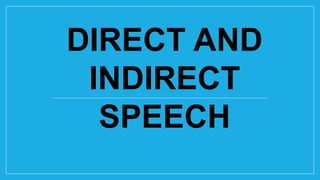
DIRECT-INDIRECT-SPEECH.pptx
- 2. Let’s analyze the sentences. 1. Uncle Joe gave me a gift. 2. My mother bought me a car.
- 3. A B 1, “Why don’t your sons give you a hand Willy?” asked Howard. 1. Howard asked Willy why his sons didn’t give him a hand. 2. Willy said, “I can throw myself on them.” 2. Willy told him that he couldn’t throw himself on them. 3. Ana said, “Willy I would have the last payment on the house.” 3. Ana told Willy that she would have the last payment of the house.
- 4. There are two ways of reporting what somebody says; • direct speech • indirect (or reported) speech.
- 5. Direct Speech describes something said being repeated exactly as it was spoken. Indirect Speech still shares the same information but instead of expressing someone’s comments or speech by directly repeating them, it involves reporting or describing what was said.
- 6. Direct Speech reports or quotes the exact words spoken. Indirect Speech is also known as reported speech. Its purpose is to report exactly what was said by someone using quotation marks. Its purpose is to report on what someone said in the past.
- 7. It is accompanied by a reporting verb, signal phrase or quotative frame. It uses reporting verbs such as: say, tell, said, talk and speak. You will keep the verb tense the same in the quotations Normally, you will change the verb tense when using Indirect Speech.
- 8. RULE 1. Changes in Verbs: If the reporting speech is in present tense or future tense, then no change is required to be made in the verb of reported speech. Direct Speech: She says, “She sings a song well.” Indirect Speech: She says that she sings a song well.
- 9. Direct Speech: You say, “I will visit London.” Indirect Speech: You say that you will visit London.
- 10. RULE 2. If the quoted part is a declarative, we use the “that clause”. Direct Speech: She says, “I was not writing a letter to my brother.” Indirect Speech: She says that she was not writing a letter to her brother.
- 11. Direct speech: Levi says, “My cat is sick”. Indirect Speech: Levi says that his cat is sick.
- 12. RULE 3. If the quoted part is an imperative sentence, change it into to phrase, and change said into told. Examples: Direct Speech: The teacher said to me, “Shut the door.” Indirect Speech: The teacher told me to shut the door. RULE 4. If the quoted part is an interrogative sentence answerable by yes or no, use the if-clause and if there is a choice we use whether-clause. Examples: Direct Speech: My friend asked,” Are you sick?” Indirect Speech: My friend asked if I was sick. Direct Speech: Mother asked,” Do you like ice cream or cake?” Indirect Speech: Mother asked whether I liked ice cream or cake. If the quoted part is a wh-question, repeat the question word and interchange the subject and verb. Examples: Direct speech: The teacher asks, “Where is your assignment?” Indirect Speech: The teacher asks where my assignment is.
- 13. RULE 5. If the quoted part is a fact or truth, no need to change the tense of the verb in the introductory part. Examples: A. Direct Speech: The professor said, “Manila is the capital of the Philippines.” Indirect Speech: The professor said that Manila is the capital of the Philippines. B. Direct Speech: Jeff said,” I am a Filipino.” Indirect Speech: Jeff said that he is a Filipino
- 14. RULE 7. Changes in Place, Time, and Possessive Words When we use indirect speech, we are reporting what someone else said in a different time and situation. Logically, we need to change some of the words from the original statement. This happens with place, time, and possessive words. Examples: A. DIRECT SPEECH: "It is sunny here." REPORTED SPEECH: She said it was sunny there. (We need to change the place word.) B. DIRECT SPEECH: "I went to a concert yesterday." REPORTED SPEECH: She said she went to a concert the day before. (We need to change the time word.) C. DIRECT SPEECH: "Harvey is our pet dog." REPORTED SPEECH: She said Harvey is their pet dog. (We need to change the possessive word.)
- 15. ACTIVITY TIME
- 16. DIRECT INDIRECT a. She says, “I am a little bit nervous.” b. She asks, "What time will you be home?" c. "There's a fly in my soup!" screamed Simone.
- 17. Match the parts of sentences from COLUMN A with the ones from COLUMN B to form logical sentences. Write only the letter of your answer on your answer sheet. COLUMN A COLUMN B _____1. Gerald mentioned that his mother... _____2. Valerie warned us that... _____3. Chelsea said her supervisor... _____4. The secretary promised she... _____5. The news reporter announced that... A. ...wanted her to complete the project by Friday. B. ...would be visiting him soon. C. ...the company was going to make a public statement. D. ...it was very dangerous to climb the mountain without a guide. E. ...would make an appointment for me.